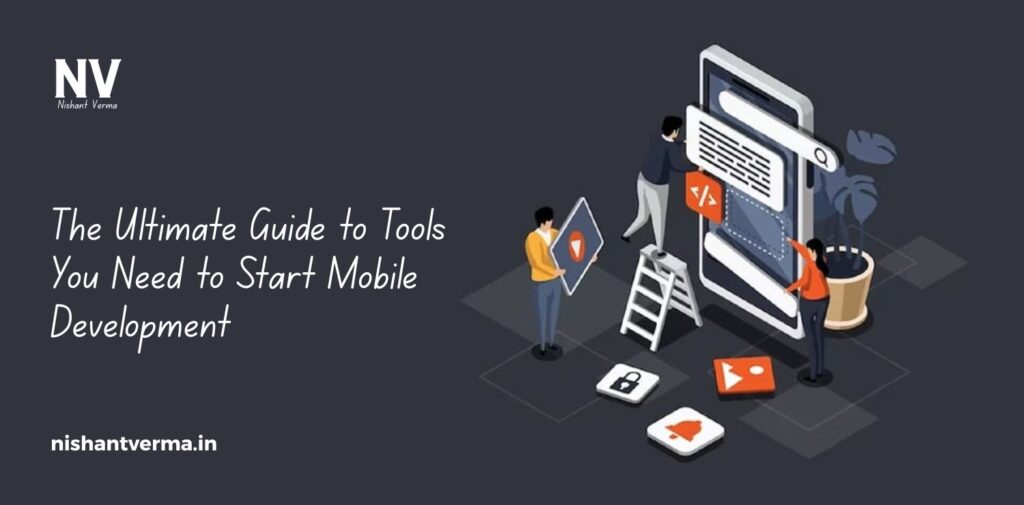Mobile development is an exciting field where you can create apps that people use on their smartphones every day. Whether you want to build games, social media apps, educational tools, or even shopping apps, mobile development is the way to go. If you’re a beginner, especially in India, and you’re curious about how to start, this guide will help you understand the tools you need. Don’t worry, we’ll keep things simple and easy to understand, just like teaching a 9 to 10-year-old!

1. Why Mobile Development Is So Cool
Before we dive into the tools, let’s first talk about why mobile development is so interesting and fun. Mobile phones are everywhere! Every time you use an app like WhatsApp, Instagram, or YouTube, remember that someone made that app using mobile development. It’s like being able to create something everyone uses. You can be the one to design fun games or helpful tools that people can download on their phones.
If you like solving problems or making creative projects, mobile development could be the perfect thing for you. The good news is that you don’t need to be a super expert to get started. With the right tools and a little practice, anyone can make apps!
2. Programming Languages You Need to Know
The first step in mobile development is learning how to talk to the phone. Just like how we talk to each other using languages, phones talk using programming languages. There are two main languages you should focus on to build mobile apps.
Java and Kotlin (For Android Apps):
If you want to make apps for Android phones (which are used by millions of people in India), Java and Kotlin are the languages you’ll need to learn. Java is an older, classic language, while Kotlin is newer, simpler, and more fun to use. Both languages are supported by Android and are used to make Android apps.
For making apps for iPhones and iPads, the language you should learn is Swift. Swift is the programming language created by Apple. It’s easy to learn and helps you build amazing apps for the Apple world. If you like iPhones, iPads, or Macs, Swift is your best friend.
3. App Development Environments
Once you’ve learned a programming language, you’ll need a place where you can write your code. This is where development environments come in. These are special tools where you can create, test, and fix your app before showing it to the world.
Android Studio (For Android Apps):
Android Studio is the main tool for building Android apps. It’s a free software that you can install on your computer. Once it’s installed, you can start writing your Java or Kotlin code. Android Studio also gives you a way to see what your app will look like on a phone screen while you are building it.
Xcode (For iPhone Apps):
For iPhone apps, Apple provides a tool called Xcode. It’s also free and works only on Macs. With Xcode, you can create apps using Swift, and it has everything you need to design your app, write code, and test it on a phone.

4. Designing the App – How It Looks
Once your app works well, you want it to look great too! Designing your app is super important because the design is what people will see when they open the app. If your app looks good, people are more likely to use it.
For Android Apps – XML Layouts:
In Android development, the design part is done using XML (eXtensible Markup Language). This is a simple way to tell your phone what buttons, images, and text should be shown. You don’t need to be a graphic designer to make things look good, but a little creativity will help you!
For iPhone Apps – SwiftUI:
For iPhone apps, you can use SwiftUI. SwiftUI is a framework that helps you design beautiful apps with just a few lines of code. It’s easy and fast, and you can see how your app will look as you create it.
5. Testing Your App
You’ve written the code and designed your app. Now it’s time to test it. Testing your app is important because you want to make sure everything works before others use it.
Emulators and Simulators:
Both Android Studio and Xcode come with special tools called emulators (for Android) and simulators (for iPhone). These tools let you run your app on a virtual phone on your computer. You can check if everything works properly and fix any problems before putting the app on a real phone.
Real Device Testing:
After testing on your computer, you’ll want to try the app on a real phone. It’s important to make sure that your app works on different devices, such as phones with different screen sizes and operating system versions. Testing on real phones helps you see how your app behaves in the real world.
6. Publishing Your App
Once your app is ready and working well, it’s time to share it with the world. In this step, you’ll need to publish your app on Google Play (for Android) or the App Store (for iPhone).
Google Play Store (For Android Apps):
To publish your app on the Google Play Store, you need to create a developer account. There’s a small one-time fee for setting up your account, and then you can upload your app. After the app is reviewed by Google, it will be available for everyone to download.
App Store (For iPhone Apps):
Publishing an app on the App Store is similar. You need to create a developer account with Apple, which costs money every year. After you upload your app, Apple reviews it, and if everything is okay, your app will be available for people to download from the App Store.

Bonus Tools for Mobile Development
Apart from the main tools mentioned above, there are other tools that can help you during the development process:
Firebase (For Adding Features):
Firebase is a tool by Google that helps you add features to your app, like storing data, sending notifications, and more. It’s simple to use and doesn’t require you to write a lot of code.
GitHub (For Sharing Your Code):
GitHub is a website where you can store your code and share it with others. It’s also a great place to learn from other developers because many people upload their apps there for you to explore.
Figma (For Designing):
If you want to design the interface of your app (like the buttons, colors, and icons), Figma is a great tool. It’s easy to use and lets you create beautiful designs even if you’re not a designer.
Conclusion: Your Journey Begins Here
Now that you know the essential tools for mobile development, it’s time to start practicing. It might seem like a lot, but don’t worry! The more you learn and practice, the easier it will become. Start with one tool, like learning Java or Swift, and then move on to others as you get comfortable.
Remember, every app you use today was created by someone who started from scratch, just like you. With patience and persistence, you can also become a mobile app developer and create apps that people will love.
So, get ready to start your adventure in mobile development. Who knows? One day, your app could be the next big thing on the Play Store or App Store!




